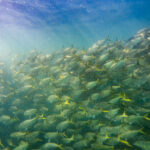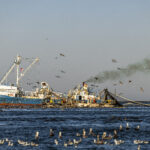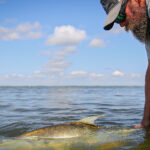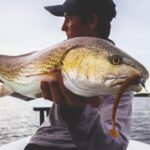
Take The Cut: Massive Reductions for Menhaden Industry Necessary
What’s going on? The “most important fish in the sea” just exposed one of the
By Will Poston, Policy Consultant
By now, you’ve likely heard something or other about the prospect of commercial-sized offshore wind farms coming to the U.S. Northeast, Mid-Atlantic, and beyond. Make no mistake—we at ASGA are fish people, not energy gurus, and were less than enchanted at the need to come up to speed on an entirely new industry. Nevertheless, we recognize the fact that offshore wind is coming to our coasts, and fast, and we can’t just sit on the sidelines. Our plan is to be constructive participants in the process and ensure that offshore wind development is as compatible as possible with fisheries and fisheries science, marine environments, and coastal communities.
To that end, last spring we developed an offshore wind policy platform, whose overriding message is the need to conduct offshore wind development according to the best available science while minimizing impacts to our marine ecosystems.
All the while, the current administration continues to make offshore wind development—and combatting climate change more generally—a top priority, as evidenced by recent events. On November 24th, the Department of the Interior, which includes the Bureau of Ocean Energy Management (BOEM), announced the approval of the second commercial-scale offshore wind farm in the United States—Orsted’s South Fork Wind Farm. South Fork is located 35 miles east of Montauk and 19 miles southeast of Block Island. The 12-turbine project is slated to begin construction in early 2022. You may remember that the first commercial offshore wind farm, the 62-turbine Vineyard Wind 1 12 miles south of Martha’s Vineyard, was approved last May, and is expected to be completed in 2023.
These are the only two commercial projects currently approved, but there are more than a dozen making their way through the permitting process that could lead to around 2000 turbines in the ocean from Massachusetts to North Carolina, as the table below illustrates. And just last week, the Biden administration announced an upcoming Offshore Wind Area auction for 480,000 acres in the New York Bight off of New York and New Jersey.

In addition, BOEM recently began identifying three new areas for potential wind development off of Delaware, Maryland, Virginia, and North Carolina—the Central Atlantic Planning Area. Granted, this is the earliest stage in BOEM’s leasing process, and these areas, outlined in red below, will be significantly narrowed down. It’s also worth mentioning that BOEM is working to bring offshore wind to the South Atlantic off the Carolinas, Gulf of Mexico and the Pacific west coast.

Impacts to Fisheries: What We Know (And What We Don’t)
How might all this impact our oceans and fisheries? We know that the few turbine structures in U.S. waters are exhibiting an artificial reef effect and are attracting marine life. From a fisherman’s perspective, this can mean more opportunities to target structure-loving species like black sea bass and mahi mahi. At this point, however, there’s still a lot that we don’t know and that we won’t know until after more projects are in the water—underscoring the importance of having robust, standardized monitoring in place to detect impacts. And while we may be able to take some lessons learned from wind projects in Europe, some of the takeaways may not translate to the unique oceanography and fisheries off our coast.
Currently, there are two pilot projects in the water—the five-turbine Block Island Wind Farm off Rhode Island and the two-turbine Coastal Virginia Offshore Wind Project off Virginia Beach. But these pilot projects only involve seven wind turbines, and only two (off VA) are in federal waters. So, while we’ll be able to understand how marine life responds to individual structures in these two locations, the true impacts at scale will still be largely unknown.
Scientists know that there will be short-term impacts associated with construction activities (e.g., securing turbines to the seabed and laying submarine transmission cables). These short-term impacts may include, among other things, noise and vibration as well as sediment transport. Additionally, there will be temporary exclusion zones for recreational and commercial boaters during construction periods. During BOEM meetings and public webinar, BOEM staff have repeatedly stated that recreational and commercial boaters will not permanently lose access to the wind farm areas. However, many stakeholders remain cautious and would prefer hard assurances from BOEM and the U.S. Coast Guard that access will be preserved.
Another important question, both for ecosystems and fisheries, deals with the long-term, cumulative impacts. Because there are no commercial-sized wind farms off our coast yet, the scientific community does not have many answers at this time. As such, we’re intent on continuing to track the scientific community’s work on how offshore wind could affect fish migrations, ecosystem composition, and fishing effort through impacts such as, but not limited to, electromagnetic fields from submarine cables, construction and operational noise, vessel traffic, and wind and ocean current alterations.
Perhaps the most obvious, tangible impact of offshore wind development for recreational fisheries will be the huge influx of stratified structure and complex habitats to seafloors. Both the Block Island and Coastal Virginia Wind Farms provide different insights based on their habitat compositions but are also experiencing increases in biodiversity and fish abundance. That increase in biodiversity, the “artificial reef effect,” is well characterized as aggregating fish and shellfish and increasing marine biodiversity.
Shortly after construction of the Block Island Wind Farm, a four-year monitoring study found that mussels quickly colonized the turbine structures, attracting other species as well. According to the study, there was a “notable increase in black sea bass,” and divers also frequently encountered “schooling striped bass at the base of the turbines.” While the Block Island Wind Farm certainly attracted fish and marine life, the turbines also increased productivy of lower trophic level organisms (plankton and shellfish), which attract forage fish and predatory fish. However, the science is not as clear to whether the structures increase productivity of predatory species, like black sea bass, or attracted them from other areas.
Down at the Coastal Virginia Wind Farm, similar aggregations of new marine life are being observed. And compared to Block Island’s rocky bottom composition, the Virginia project area is entirely sand bottom. Check out this article for underwater footage at the Coastal Virginia Wind Farm.

Making Lemonade: Mitigating Impacts
To reiterate, there is still a lot that we (meaning everyone in the offshore wind discussion) do not fully understand. That makes it all the more necessary to conduct baseline data and monitoring studies, develop guidelines to mitigate future impacts, or even perhaps require developers to make habitat enhancements throughout their project. Just a couple of weeks ago, ASGA submitted comments to BOEM about mitigating impacts to recreational fisheries from offshore wind. Our letter can be viewed here.
While the Block Island Wind Farm’s turbines use a jacketed design that offers more artificial structure, the Virginia wind turbines are secured to the sea floor with a monopile design. It’s worth noting that nearly all of the projects in the permitting pipeline plan to employ the monopile design.

Many foundation types, including monopile designs, require scour protection to stabilize the turbine—think thousands of truckloads of stone or rock materials placed at the base of each foundation to prevent erosion caused by tides and currents. In the case of Vineyard Wind 1, the Construction and Operations Plan anticipates each turbine will require 0.37-0.52 acres of scour protection—around the size of half a football field. For fish and fishing, scour protection means increased complex bottom habitats in many regions where no such complex habitat was present.
The Nature Conservancy’s (TNC) new Turbine Reefs initiative is hoping to test and monitor deployment of specific materials and structures to make the necessary scour protection even more beneficial for marine life. This strategy echoes the Wind Energy Policies of both the Mid-Atlantic and New England Fishery Management Councils, which both recommend that if “scour protection or cable armoring is needed, the materials should be selected based on value to commercial and recreational fishery species… Natural materials, or materials that mimic natural habitats, should be used whenever possible.”
TNC identified all the available nature-based design materials currently made in the United States and provided suggestions for how the ecological function of offshore wind structures could be enhanced by adding these designs to offshore wind structures, per the Turbine Reef report. These nature-based design structures range from repurposed concrete to intricate vertical structures that are made from pH-neutral concrete to encourage further colonization.
“As we buildout offshore wind energy, there is great potential to enhance and create new fish habitat,” explains Carl Lobue, The Nature Conservancy’s New York oceans program director, who is involved in this collaboration, not to mention a seasoned angler and recent guest on ASGA’s podcast, The Guide Post. “With intentional design and material selection, these new structures could support entire communities of marine life.”
This whole offshore wind discussion is tricky. Here at ASGA, our number one concern is that much of the science is being outpaced by development. How can we be sure of long-term impacts when the oldest offshore wind project in U.S. waters is five years old? How will these new artificial-reef-producing structures impact fishing effort and recreational fishing data? What will be the cumulative effects of hundreds of turbines across adjacent wind farms? Collecting baseline data, standardizing monitoring across projects, and ensuring efficient sharing of information on impacts will be essential for those questions, and is exactly what the Responsible Offshore Science Alliance is promoting. In the interim, it’s encouraging to know that the projects in the water now appear to be benefiting marine life. On the other hand, as the scale and impacts of offshore wind increase dramatically over the next several years, it’s critical that we work to be proactive where we can and “prepared to react” where we can’t in order to minimize impacts to fish and fishermen alike.

What’s going on? The “most important fish in the sea” just exposed one of the

Mario CampoFisheries Ecologist, Southeastern Louisiana UniversityScience and Policy Associate, American Saltwater Guides Association This discussion

The Jack Project continues to gather momentum as tagging teams across the Gulf and South

This guide is meant to educate anglers, conservationists, and the public about the Atlantic States
We rely on our members and donations to keep fighting for a sustainable tomorrow in marine conservation.
New science shows 275,000,000 lb discrepancy that requires immediate action!
GIVE THE GIFT OF FISHERIES CONSERVATION THIS HOLIDAY SEASON. SHOP ASGA GOODS THAT FUND FISHERIES RESEARCH & ADVOCACY CAMPAIGNS
JOIN ASGA IN CALLING FOR CRITICAL MANAGEMENT ACTION AFTER YEARS OF SPAWN FAILURES & POOR MANAGEMENT.
By using this website, you agree to our use of cookies. We use cookies to provide you with a great experience and to help our website run effectively. To learn more, please review our privacy policy.
2 Responses
Are you monitoring the affects of low frequency vibration on aquatic life from turbine?